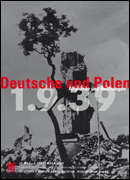


Exhibition | Oppression and Self-assertion | War and Occupation | Conflicts and Rapprochements
The Partitions of Poland
| Struggle for Freedom and Enthusiasm for Poland
Intensification of the "Germanization policy"
| World War One and the Reconstitution of Poland
Border Conflicts and Demonization
| A Calculated Rapprochement
The Versailles Treaty of 1919 did not define all of the boundaries between Germany and Poland: a final decision on the borderline in Upper Silesia and parts of Western and Eastern Prussia was to be made through plebiscites. The plebiscite for Upper Silesia, a region of economic importance, was attended by violent clashes. About 40 percent of Upper Silesians voted for Poland and 60 percent voted to stay in Germany.
In view of the outbreaks of violence on both sides, the Allied Supreme Council decided to divide Upper Silesia, and the eastern part, the area of greater economic importance, fell to Poland. This decision evoked a storm of protest in Germany.
The German government refused to recognize its boundary with the Republic of Poland until 1933. The German minority in Poland was subjected to repression in many cases, and many Germans denied Poland's right to exist. Meanwhile, many Poles perceived German policy after 1918 as a continuation of Germany's anti-Polish policy under the German empire.
